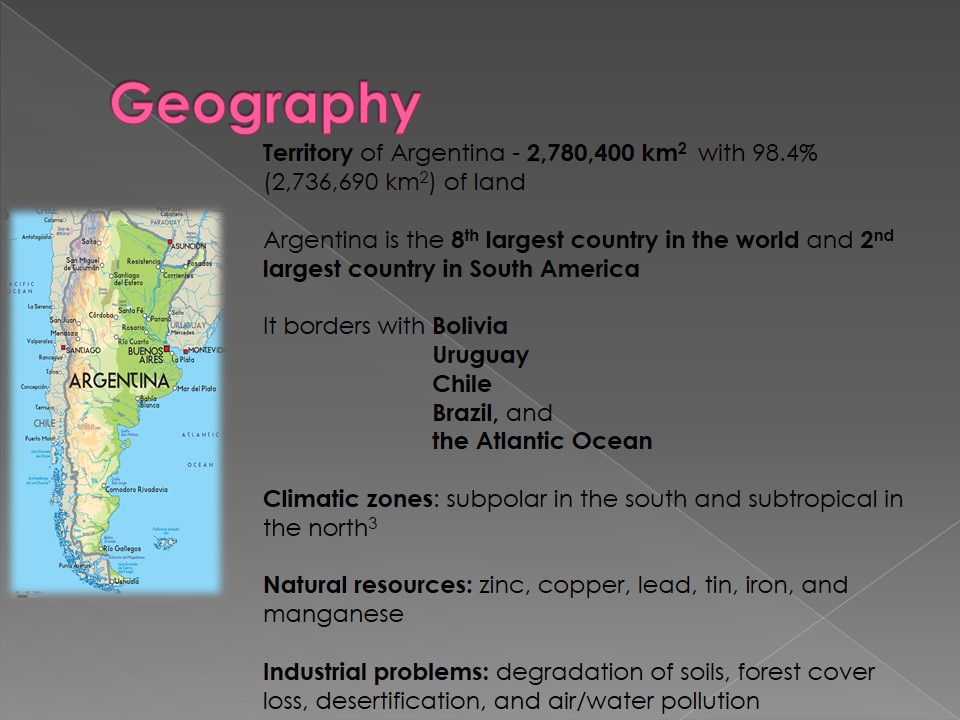Introduction
Principles of economics help to understand the current situation and the possible development of the country
- This project aims at exploring the following situations in Argentina:
- political,
- economic,
- social.
- and reviewing the country’s:
- geographical,
- demographical,
- governmental.

Historical Background
- Argentina’s territory was discovered in the 16th century.
- Spanish Empire colonized Argentina to extract gold and silver.
- 1816 – Argentina became independent from Spain.
- Paraguay, Bolivia, and Uruguay were separated from Argentina.
- The era of Peronism began after the Second World War.
- 1983 – Argentina became democratic
- 2016 – Mauricio Macri is the president.

Geography
Territory of Argentina – 2,780,400 km2 with 98.4% (2,736,690 km2) of land.
Argentina is the 8th largest country in the world and 2nd largest country in South America.
It borders with:
- Bolivia;
- Uruguay;
- Chile;
- Brazil;
- the Atlantic Ocean.
Climatic zones: subpolar in the south and subtropical in the north.
Natural resources: zinc, copper, lead, tin, iron, and manganese.
Industrial problems: degradation of soils, forest cover loss, desertification, and air/water pollution.

Population of Argentina
- Population of Argentina is 43,887,700 people.
- 91,8% of the population live in urban areas.
- 97% are White.
- Annual growth of population is about 0,93%.
- Average life expectancy at birth is 77,1 years.
- Literacy rates – 98,1%.
- Unemployment rates – 18,3%.
- Religion:
- Christianity is dominant,
- Roman Catholics (92%),
- Protestants (2%),
- Judaists (2%),
- and other (4%).

Government of Argentina
- Since 1983, Argentina is a democratic country.
- Argentina is a federal constitutional presidential republic.
- The president is chosen every four years.
- The main legal document is the Constitution of Argentina.
- Legislative branch: the National Congress and the Chamber of Deputies.
- Judicial branch: the Supreme Court.
- Administrative branch: 23 provinces with local governments and the capital Buenos Aires.
- Parties: 11 political parties with a certain influence.

Economic Background
The main characteristics of Argentina:
- natural resources;
- large land territory;
- numerous agricultural processes;
- diverse industrial processes.
Argentina is export-oriented:
- 51,1% of GDP – the agricultural sector;
- 31,6% of GDP – the industrial sector;
- 8,8% of GDP – the mining sector;
- 8,5% of GDP – other sectors.

Political Instability
2001 – 2002 was the period of certain political, economic, and social crises.
The Central Bank canceled the peso/dollar exchange rate that was 1:1.
2002 – GDP was decreased considerably.
High poverty rates.
People cannot gain control over their financial situations.

Economic Recovery
President Nestor Kirchner offered several effective policies and steps to promote the recovery of the country in the political and economic spheres.
- In 2010, the country experienced considerable improvements.
- In 2011, the governmental interventions took place.
- In 2012, the foreign reserves were improved.
- In 2013, the government gained control over the foreign trade of the country.
- In 2015, a new president, Macri, liberalized the country’s economy.

Government’s Interventions
Macri helped to save the country from a new economic crisis in 2015 and took a number of steps to support its people and develop the required portion of international relations:
- stabilization of the economic situation;
- control of an unsteady economy;
- large volumes of import;
- necessity to be export-oriented.

GDP
- GDP Indicators:
- 2013 – $885,2 billion;
- 2014 – $862,9 billion;
- 2015 – $884,2 billion.
- Growth Rate:
- 2013 – 2.4%;
- 2014 – -2.5%;
- 2015 – 2.5%.

Poverty Rates
- Poverty Rates:
- In 2010, 30% of population suffered from poverty.
- Inflation Rates:
- Since 2010, the rates were not improved.
- Public Dept:
- In 2015, it continued to grow so that the President decided to liberalize the economy.
- Predictions:
- Poverty rates and public debts could be reduced during the next year.

Conclusion
Argentina is rich in:
- territorial,
- mineral,
- social,
- economic resources.
What Argentina needs is:
- effective leadership,
- proper management,
- time.

Reference List
- Central Intelligence Agency, ‘The world factbook. South America: Argentina’, Central Intelligence Agency, 2016b. Web.
- Reuters, ‘Argentina lifts currency controls, floats peso in bid to boost economy’, The Guardian, Argentina, 2015. Web.
- Hobbs, J. J., World regional geography, 6th edn, Brooks/Cole Cengage Learning, Belmont, 2009, p. 596.
- Central Intelligence Agency, ‘The world factbook. Country comparison: Life expectancy at birth’, Central Intelligence Agency, 2016b. Web.
- Levitsky, S.& Murillo, M. V., Argentine democracy: The politics of institutional weakness, The Pennsylvania State University Press, University Park, PA, 2005, p. 5.
- Flannery, N. P., ‘Will Argentina’s economy finally start to recover in 2016?’, Forbes, 2016, para. 1. Web.